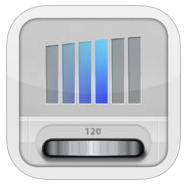Although it is often misused and disliked by beginner music students, a metronome can be the ear trainer’s best friend. Let’s look at some of the ways you can use a metronome to improve your ears.
Before we get started though, what metronome is best? You can use a traditional mechanical metronome, a modern electronic metronome, or even a metronome app on your smartphone or tablet. Here are two we recommend:
Recommended Metronome Apps
Android

Tempo Metronome
So how does using a metronome help you with ear training?
1. Internalise a rock-steady beat
This is the biggest advantage a metronome gives you. As a musician you need to have a rock-solid sense of the beat. Everything in music is built on that steady (or sometimes intentionally not-so-steady!) tick, tick, tick, tick.
One of the most noticeable traits of beginner (or just bad) musicians is that they have unreliable musical timing. They have not yet developed their “inner metronome” and so their playing sounds sloppy, even if they hit all the right notes.
Practising regularly with a metronome helps enforce the steady beat and over time you will find your internal sense of the beat becomes clearer and more reliable. Eventually you won’t even need the metronome to play perfectly in time, every time.
2. Free your attention
While that steady tick-tock of the metronome keeps you in time and passively develops your internal metronome, your mind is actually freed up to focus on other aspects of music.
Once you get past the initial discomfort of unfamiliarity, it is actually easier to practice your pieces with a metronome playing, because you don’t need to pay so much active attention to staying in precise time. The metronome helps you do that, freeing up your musical mind to think about pitch, dynamics and phrasing.
3. Learn to estimate tempos
Each time you set the tempo on your metronome, try to tap out the correct beat yourself first. At the start you will probably be able to do a few simple tempos like 60BPM or 120BPM, but it is possible to develop a very sophisticated ability to estimate tempos, so that you need only look at a piece of sheet music labeled e.g. 75BPM and be able to play it at the right pace.
4. Become more sensitive to tempo changes
As you train your ears for tempo estimation and that rock-solid sense of beat, you will find you become more sensitive to variations and changes in tempo.
From long accelerandos and decelerandos which change the overall pace of the music, to small or temporary adjustments used for musical expression, having an ear which easily detects changes to tempo is a key part of high-level musicianship.
5. Gain power over the beat
When you listen to a truly moving performance, the chances are that the musicians are able to create that effect by how they “play with” the tempo and dynamics of the music. More than just playing the right notes at the right time, true musicality depends on an ability to interpret the “correct” pitch, timing and volume and add your own expression to it.
To be able to play around with the beat and add character to your performance, it is essential that you are first anchored in a rock-solid sense of the beat and tempo. Otherwise your creative changes will just sound messy.
Train your ears using a metronome and you will find new freedom to manipulate the beat, confident that you are grounded in a solid accurate tempo.
Why you should use a metronome
You may have had bad experiences with metronomes in the past, particularly if an instrument teacher forced you to play endless scales with the metronome beat ticking away. But hopefully you now see that the metronome can be a very useful tool for you in a number of ways as you develop your ears and become a more sophisticated and impressive musician.
Similar questions answered on this page:
- How can I use a metronome for ear training?
- How can I improve my sense of rhythm?
- How do you do tempo ear training?







